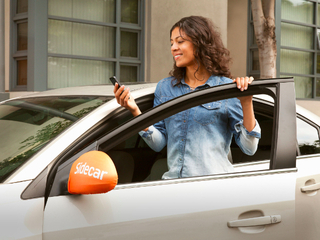DUOS expands AI capabilities to help seniors apply for assistance programs
It will complete and submit forms, and integrate with state benefit systems
Read more...What a year!
2015 definitely marked the ever-increasing rise of the sharing economy company, with Uber continuing its massive fundraisings and quest for world domination, a complete lack of public offerings, and other big headlines.
In any case, here are my predictions for what we should expect Uber, Airbnb and the rest of the space next year.

1. The bubble will continue to deflate
As I wrote in yesterday’s “failed predictions” article, many analysts a year ago expected that 2015 would be the year that the technology bubble burst. I classified it as a missed prediction because a burst suggests a more cataclysmic end along the lines of what we saw at the end of the dot-com era.
Unlike the dot-com bubble, characterized by crazy speculation in the public markets, the current bubble is largely relegated to the private markets, which have fostered a frenzy for unicorns. Today there are nearly 150 companies valued at or above $1 billion, and 14 of those are valued at or above $10 billion.
Though an explosive end never materialized, we did see in the final months of 2015 some slight deflating of technology investor hype. In 2016, we’ll see more of this.
Entrepreneurs will have to work harder to demonstrate the value of their startups if they want to raise capital. And those that do stand out and secure investor interest will not be raising as much money as their counterparts did in early 2015 or 2014.
In other words, the market will come back to reality, which is a good thing.
2. Uber won’t file for an IPO
Many analysts thought that Uber, the biggest unicorn by a mile with a reported $62.5 billion valuation, would go public in 2015 if not early 2016. But the company hasn’t even filed to go public yet, and you typically need a 3-4 month runway after the initial S-1 filing.
Though it’s still the biggest company on the private market, Uber won’t go public in 2016. I strongly believe this because I believe Uber CEO Travis Kalanick spoke the truth at the Wall Street Journal’s WSJDLive conference in October: “We’re maturing as a company, but we’re still like eighth graders. We’re in junior high. And someone’s telling us we need to go to the prom, but it’s a little early. Give us a few years.”
In a sense, Uber is like a puppy that grew huge really quickly, but still acts like a puppy. Though the company has expanded internationally in its quest for world domination, the company resembles a young startup in its ability to test new, innovative schemes (like UberEATS) relatively quickly.
The company has a lot of room to grow, and it wants to mature a bit more for going public.

3. Airbnb will file for IPO
Airbnb, on the other hand, is ready for primetime.
Since its founding in 2008, the San Francisco company has grown into a full-scale, international operation, offering approximately two million listings in 57,000 cities in 150 countries across the globe. The company manages 500,000 nightly bookings, on average, arranged between the site’s 640,000 hosts and 50 million users.
Most importantly of all, however, we’ve been able to confirm with a source close to the company that it is expecting to be profitable sometime next year. And profitability is a nice thing to have when you go public.
Today the company doesn’t have much serious competition, except from HomeAway, which was acquired by Expedia for $3.9 billion in November, and the traditional hotel industry. So not only will this IPO happen, but it will be a hot one.
4. Didi Kuaidi will acquire Lyft
Consolidation in the ride-hailing space is inevitable. In fact, it’s already underway.
In February 2015, Chinese companies Didi Dache and Kuaidi Dache merged to form Didi Kuaidi, which is today’s most highly valued on-demand company on the private market after Uber. The company, currently valued at $15 billion, has raised several billions of dollars.
Then, in the second half of the year, Didi Kuaidi formed an official customer-sharing partnership with Lyft, Uber’s primary competitor in the U.S. The two-company partnership quickly expanded to a four-company alliance with the addition of OlaCabs in India and GrabTaxi in Singapore.
So what’s next?
Either the partnership proves fruitful in stemming Uber’s advancements around the world, or it fails. The partner’s expansion already demonstrates positive results, so I imagine that the next logical step would be an even closer partnership—in other words, a merger or acquisition. I don’t think it would affect customers much, but it would let the companies collaborate even closer on defeating their massive nemesis.

5. Uber will succeed where Sidecar failed
Sidecar, one of the earliest ridesharing companies, announced earlier this week that it was shutting down. After serious competition with Uber and Lyft, the company had pivoted in early 2015 to food delivery. Unfortunately, competition in that sector is just as fierce, and ultimately Sidecar couldn’t cut it.
Thanks to its massive warchest and growing experience, Uber will be able to succeed where Sidecar failed. The company has been more conservative with the launch of UberEATS, which a GeekWire review found to be the fastest restaurant delivery service on the market.
Today the service is available in 10 U.S. cities, including Los Angeles, New York, and San Francisco, plus Paris and Toronto. In 2016, Uber will continue to refine the food service in those cities while expanding to new markets where its flagship Uber service is already available.
6. Several food delivery startups will go out of business
Though Sidecar’s entrance to the food delivery market was a somewhat late pivot, that’s not the only reason the attempt failed. Another big reason is that the market is simply overcrowded with overvalued startups attempting to own a really simple concept: getting food from A to B.
The biggest name in the space, Instacart, has raised nearly $275 million and is today valued at $2 billion. And that’s technically a grocery delivery startup, not a restaurant food delivery service. HelloFresh and Blue Apron are a couple other unicorns uniquely focused on grocery deliveries for meals.
When you look at restaurant delivery, the crowd expands even more, with GrubHub, Seamless, and even Amazon Local and UberEATS vying for your wallet. In 2016, we’re going to see the underfunded, smaller teams either going out of business or folding into the bigger players.

7. More unions will be approved for Lyft and Uber drivers
At the end of 2015, the relationship between Uber/Lyft and their drivers was looking really interesting.
In California, a federal judge has ruled that anyone who has ever driven for Uber in California (almost 160,000 drivers) can participate in the lawsuit which will determine whether drivers should be reclassified as employees. Currently, as independent contractors, drivers are responsible for their own “business expenses,” including fuel, car maintenance, and cell phone bills.
To date, several states have ruled to classify Uber drivers as independent contractors: Texas, Pennsylvania, New York, Indiana, Illinois, Georgia, Colorado, and California. And I honestly think California will continue to maintain this classification when the lawsuit is brought to a conclusion.
That said, I predict more cities and states will go down the trail blazed by Seattle: approving unions for drivers. They’re certainly contracting out to Uber and Lyft, but that doesn’t mean drivers shouldn’t have a way of bargaining with the companies for better wages or working conditions.
8. Uber will invest heavily in fully autonomous cars
Unfortunately for those same drivers, the opportunity to use Uber and Lyft as a supplemental income is going to disappear sooner than they think. Once these companies can deploy fully autonomous cars and thereby cut out an unnecessary expense—the driver—they’re going to do it.
It’s a bit optimistic to think we’ll be seeing fully autonomous cars on city streets by the end of 2016, but it could realistically come to fruition by 2020. In the meantime, there’s a lot of work to be done both technologically and legally to make vision this a reality. Expect Uber to either partner with a major car company (Tesla?) and kick its lobbying power in overdrive. With all the driver battles happening across the country, the company wants to get rid of drivers as soon as possible.

9. Uber for friends (and maybe more than friends)
Hat tip to Frog Design for originating this idea. But I just love it.
Though investments and valuations might have peaked, we still haven’t reached total saturation of sharing economy companies. In other words, we have cars and homes and workspaces on demand, but there are still things that aren’t available from on-demand services. And by “things,” I mean “people.”
In 2016, we’ll see the rise of a line of apps and services promising the ability to “hail” or “rent” a friend on the fly. Whether you need a date for that concert or just a buddy to join you at the bar for a game, there’s a startup hoping to solve these needs. I also believe that, yes, maybe these friends will sometimes be more than just friends.
And before you tell me that escort services already exist, let me just say that taxis also existed five years ago. But today a company that provides transportation around the city is still the most highly valued company on the private markets.
10. Taxis will thrive
I really just want this to happen. Sure, Uber and Lyft give each other sufficient competition, but keeping taxis alive will be in the best interest of the customer—both in terms of keeping prices low and quality of service high.
Taxis, in San Francisco at least, offered atrocious service a few years ago. Then Uber and Lyft showed up and blew up the industry, forcing taxi drivers to update their overall strategy, their technology, and their attitudes. Technology companies like Flywheel are helping the old industry to get with the times, replacing their outdated equipment with easy smartphone technology you see in Uber and Lyft cars.
People still buy taxi medallions in the city, and I predict the number will even go up next year. Of course, for this to actually become reality will require more than just technology like Flywheel. We’ll need tighter regulations on the upstarts (Lyft and Uber) and more equal rules for the taxi industry.
Either way, you’ll be able to catch a taxi in the wee hours of New Years’ Day 2017.
It will complete and submit forms, and integrate with state benefit systems
Read more...The bill would require a report on how these industries use AI to valuate homes and underwrite loans
Read more...The artists wrote an open letter accusing OpenAI of misleading and using them
Read more...Startup/Business
Joined Vator on
Lyft is a peer-to-peer transportation platform that connects passengers who need rides with drivers willing to provide rides using their own personal vehicles.
Startup/Business
Joined Vator on
Uber is a ridesharing service headquartered in San Francisco, United States, which operates in multiple international cities. The company uses a smartphone application to arrange rides between riders and drivers.




